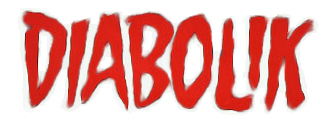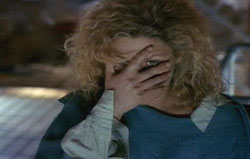| Release List | Reviews | Price Search | Shop | Newsletter | Forum | DVD Giveaways | Blu-Ray/ HD DVD | Advertise |
| Reviews & Columns |
|
Reviews DVD TV on DVD Blu-ray International DVDs Theatrical Reviews by Studio Video Games Features Collector Series DVDs Easter Egg Database Interviews DVD Talk TV DVD Talk Radio Feature Articles Columns Anime Talk DVD Savant HD Talk Horror DVDs Silent DVD
|
DVD Talk Forum |
|
|
| Resources |
|
DVD Price Search Customer Service #'s RCE Info Links |
|
Columns
|
 |
DANGER:
|
|
Note, June 15, 2005: Eight years later, there is now a sensational Paramount DVD of Danger: Diabolik. |
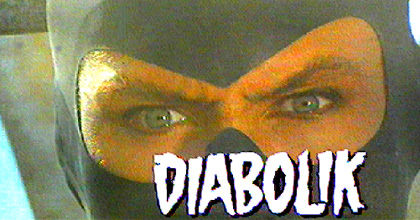
|
This article gets really deep into one cult movie and pulp fantasy in general. If it's too esoteric, well, enjoy the pictures, and see you next week!
If going crazy over a film could get someone into jail, Savant would be locked up for the crime of loving Danger: Diabolik, an Italian thriller about a super criminal, filmed by cult horror director Mario Bava for Dino de Laurentiis in 1967. I'd read about the movie (original Italian title, Diabolik) in John Baxter's Science Fiction in the Cinema. 1 Baxter described a movie that captured the style of a comic book far better than its much better-known sister film Barbarella. Savant liked the music and the sexiness of Barbarella (they let 16-year-olds in!) but knew even then that the Roger Vadim space opera was no work of art.
Danger: Diabolik did floppo boxoffice and never reached Savant's home town. In Italy and the rest of Europe it had been a big hit. Paramount probably dumped it into a few US double bills and watched it disappear, with other 60's imports practically unseeable in the states: The Assassination Bureau, The Wrong Box, The Italian Job. This, of course, was way before home video so chances of viewing Diabolik in a theater were almost nil.
Then the film played in a Santa Monica midnight series run by one Harriet Diamond, who regularly showed hard-to-see movies after the regular fare let out. She taped a sign on the boxoffice telling people that this was not Les Diaboliques by Clouzot. it certainly wasn't. TV's Batman had tried to make fun of the moral code that inhibited American fantasy adventures. This amoral, basically anarchic movie came from an entirely different universe. In blazing Technicolor and widescreen (not anamorphic), Danger: Diabolik was like pulp eyewash, a supercriminal fantasy completely unhindered by convention.
Arch criminal Diabolik (John Phillip Law) lives to steal and no treasure is safe from his clutches, no matter how hard Inspector Ginco (Michel Piccoli), his police force, and a whole army try to stop him. Shocked expressions and blasts of Ennio Morricone music accompany even the slightest mention of the name Diabolik; time and again he bests his opponents with comic-strip cunning and ridiculous gadgetry. He lavishes his loot on his ever-faithful partner Eva Kant (Marisa Mell), a statuesque beauty who aides him in his capers and loves him on a romantic plane of surprising believability. Besides Diabolik's sex life, what plot there is works around three caper episodes held together by the device of Ginco blackmailing gangster Ralph Valmont (Adolfo Celi) into catching Diabolik for the law ("We got the know-how the cops don't. If we all get together on this - tough luck, Diabolik!").
Everything about Diabolik is style. Bava's masterful camerawork, which in his horror films was often restricted to claustrophobic sets, here opens up into the bright sunlight and some dazzlingly elaborate sets (many of them clever Bava miniatures). The lenses used range from wide to extremely wide, giving almost every shot a distorted depth that lends the film a consistent comic book dynamism. Already spider-like in a head-to-toe black leather leotard, Diabolik often moves from a small figure on the screen to immense close up in just two or three distorted steps. Strange diagonals split the frame and bizarre op-art set dressings float like suspended cartoon dialog balloons. Bava extends the Feuillade-Fantomas-Judex pulp connection with electrified shots completely unlike the quaint hommages of Jean Cocteau and Georges Franju. A gloved arm reaches into frame to dial a combination safe like the ghost of Dr. Mabuse or Rotwang; at his own autopsy, Diabolik's fiendishly intense eyes flash open with a crash of cymbals announcing that no ordinary mortal has returned from the dead.
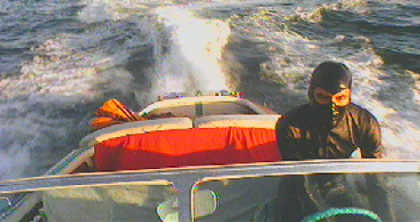
|
Bava's orchestration of Diabolik's world stresses strangely fetishistic surfaces and textures, backing up film theorist Raymond Durgnat's assertion that the psychic land of pulp fantasy is fundamentally a sexual one. |
The acquisition of material luxury is what Diabolik is all about, and Bava makes everything in the film look lush and luxurious.
His leather suit comes both black and creme-colored, like a designer sofa. His rubber mask covers his entire face except for his exaggerated eyes, and is such a tight fit, in some shots it looks painted on. When Eva peels it away, it's as if she were shedding his skin.
No director ever used color like Bava, and here the variety of stunning visuals goes far beyond his catalog of horror effects. Clouds of multicolored smoke, used to snooker the cops or to give the bureaucrats a dose of laughing gas, have a circus-like feel to them. Simple fleshtones in the elevator makeout sequence have a Technicolor intensity that turns some simple smooching and groping into a really hot sex scene. Aqua reflections from Diabolik's grotto moon-pool dance equally effectively across Eva's body. A bushel of crisp dollar bills covers them as they make love on a rotating circular bed. And molten gold glimmers in its ingot molds while Diabolik chortles out his villainous signature laugh. A cameraman once told me he thought Bava was using complimentary additive light on his subjects with color filtered key spotlights. Where both spots 'mixed' the colors combined to produce near-white key light, but where they fell independently on the sides of objects, they would stay as pure hues. This theorizing might explain where Bava gets his hallucinatory trademark visuals, where people and objects are bathed in primary blasts of red or green. Certainly not realistic source lighting, it's a breathtaking 'look' that is Bava's own. (Whew!)
For simple fun, Diabolik easily outdoes TV's Batman in scenes like Terry-Thomas'es news conference, which falls apart in uncontrolled, infectious laughter. The makers even take a poke at Barbarella when her cartoon image comes up as a choice in the sketch machine used to identify Eva Kant. 2 American spy spoofs of the period were always trying for a tongue-in-cheek quality that Bava achieves effortlessly. In a photographer's disguise that would fool nobody, Diabolik pauses to look directly at the camera, an aside that says 'Don't be fooled, it's me alright.' And Eva's triple take of evasive glances while hoodwinking the uncomprehending Ginco ("I was expecting you Inspector") captures the essence of camp tongue-n-cheek: collusion with the audience.
Savant spent years in the wilderness howling the praises of this film to deaf ears: the technically obsessed effects people I hung out with rolled their eyes at it. But effects man Robert Short was a big fan, as was Jim Wynorski, for whom I screened my first mangled print of the film in 1979. Harlan Ellison also saw it for the first time at that party (Savant can name-drop with the best of them) and then talked about it on his radio show on and off for the next several years. Of late, both Quentin Tarantino and Tim Burton have been quoted mentioning Bava as influences, and some writers have narrowed that down to include Diabolik in relation to Burton's darker, dynamic Batman movies. Visually, Diabolik plays well for contemporary audiences - but it functions on a visual level that doesn't use rapid-fire cutting. It's Euro Cocktail, lush and leisurely as only European movies can be. Michael Bay fans need not apply.
Politically, Bava and his screenwriters retain much of the anarchy of Diabolik's source, the Italian comic of Angela and Luciana Giussani. 3 As in their original, Diabolik's plundering has destabilized the government ( Italy?, France? ) into constant turmoil. Embarassed officials and bureaucrats lose their jobs over their failure to stop him. Diabolik also retains a number of his nastier comic habits: the criminal fiend thinks nothing of contemptously killing policemen right and left, and at one point dynamites a couple dozen government buildings for little more than a lark, a personal statement to prove that his threats are never bluffs. As un-PC as this is, it's the logical end of violence in popular art: nobody cries over the families of the guards killed by Robin Hood, or the innocent bystanders shot for kicks by der Schwartzenegger in Total Recall or Terminator 2.
What does it all mean? Well, the Giussani sisters may have meant the chaotic political state caused by Diabolik's depredations to mirror the rollercoaster Italian politics of the time, which seemed to flip-flop from conservative to socialist and back again on a weekly basis. Diabolik's unfettered greed and incredible nerve in seizing what he wants, no matter what the price to society, seems to represent the ultimate end of materialist consumerism, what it would really take to achieve the glossy fashion-magazine dream of Italian luxury. He's truly out for himself alone, and his ultimate fallability is achieved in a symbolic climax that shows him literally becoming a pillar of greed, just as Lot's wife became a pillar of salt in Robert Aldrich's Sodom and Gomorrah.
Fantasy heroes are usually lacking in depth. Diabolik may barely achieve even one dimension, but does so with a clarity that makes audience identification simple. He's the final distillation of the idea that we love criminals because we secretly admire the transgressions they represent. Even Ginko's admiration for Diabolik goes beyond the usual grudging acknowledgement of kinship. And Eva's adoring faithfulness is so physical and pure that the sincerity of their farewell ("You'll not be alone while I live!") is tenderly affecting. In the final scene she swoons down the full length of Diabolik's body in total sexual worship of him, dead or alive.
The original screenplay contains many elements either jettisoned or altered, presumably at least partly by Bava. There is easily twice as much dialogue that was pared down. Every scene with Eva is scripted with nudity or sex, as if these elements were written in to sell the property even though all involved knew they would be dropped. The killings read as more graphic in the script, with tortures and grue dwelled upon sadistically. Finally, the script gives Eva and Diabolik a robotic houseboy named Italo, a pretty lame version of Robby the Robot to provide foolish comedy relief.
American reviewers who dismissed Danger: Diabolik as total junk were looking for its merit in the script and dialog, doing the usual critical thing of judging a movie by its literary content. Bava achieves everything visually, in a pulp realm where dialogue is largely inconsequential. Diabolik works as a movie, unconsciously communicating ideas as, well, as cinema. Paramount's ads tried to sell it as a spy spoof, playing up the gadgets and not showing the hero/villain in his comic strip mask. Reviewers judged it negatively against hits like The Silencers. The Silencers today plays like artless trash, 4 whereas Danger: Diabolik dazzles like an ageless jewel.
|
Bava exponents, chiefly Tim Lucas of Video Watchdog, have been great sources of information, such as the fact that Bava brought the film in at a tiny fraction of the budget de Laurentiis put at his disposal. |
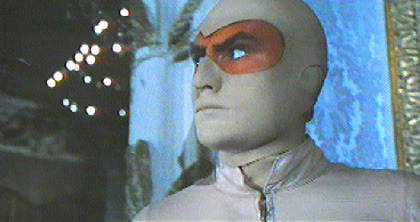
|
Bava had his way of doing things quickly and cheaply and must have been trying to impress Dino or teach him a lesson about production values. Or perhaps Bava simply realized that the big budget approach was incompatible with his style of operation. No matter.
Diabolik is a hundred times more interesting than the slapdash Barbarella, which constructs some interesting sets but is mostly a big cardboard bore. Mr. Lucas also reported that the reason Diabolik's crazy soundtrack has never been released is because it was lost in a garage fire. Since everything else in Ennio Morricone's career has been issued at least once if not three times, that was an explanation Savant dreaded to hear. The weird sitar themes and guitar riffs, not to mention the explosion of music in the pot-smoking scene, are some of Morricone's best.
Several sources call the pot-smoking scene a restored one; Savant remembers it from the midnight screening (presumed to be Paramount's archival print) and it was also in Film Incorporated's 16mm prints as well as two junked 16mm prints bought by Savant in the 70's.
Diabolik was a true international production - its stars were spread across four countries and three languages; simultaneous English, French and Italian versions were prepared from the beginning. Subtitled prints were never made for its primary markets.
A special note that few fans are aware of: the Paramount EP vhs and laserdisc have beautiful color and letterboxing (laser only) but are also marred by a misleading remixed soundtrack. Either no English language materials could be located, or some legal snare kept them from being cleared. Even the title sequence is in Italian (no 'Danger:' in the title). This makes sense because when trying to locate a studio 35mm Technicolor print in 1985 for a Filmex screening, David Koenigsberg reported that it had been given back to de Laurentiis in 1980, and the de Laurentiis people replied that it had been chopped up for sound fill (!).
Perhaps the English dialog dubs were lost along with the music, because the new release contains only elements for the Italian version, except for tracks for English speakers John Phillip Law, Marisa Mell and Terry-Thomas. The original '60's dubbing tracks for the continental talent have all been revoiced. For instance, Adolfo Celi's voice was the same used in Thunderball, not the new one dubbed for video. His 'Dry up, stupid!' just doesn't have the punch it used to. Along with most of the minor parts, Frenchman Michel Piccoli sounds simply stupid now in contrast to his old voice. In the original, Diabolik was pronounced DIE - a -bolik, but the new tracks revoice him as DEE - a - bolik, presumably the Italian pronunciation. And some telling phrases have been altered, presumably by interfering Paramount lawyers, who change Lady Clarke's "I feel as if I'm living in the old days of Robin Hood,' to 'old days of highway robbers,' as if Robin Hood might be someone else's trademark.
Worst of all is the remix of the Morricone score, which originally filled the track at top volume, prompting the Variety reviewer to slam it for having 'the lush sound of an FM radio station selected at random.' The new mix drops the volume of major cues in favor of minor sound effects. The 'action' guitar riff amused with its repetitious monotony, but the new mixers elected to background it instead of letting it crash in loud n' hard each time. I remember that particular music cue getting laughs and applause of its own, as the audience got into the unique humor of the film. The only good Savant can find with the new track is that, assuming Paramount really lost the English language masters, not rerecording would result in Diabolik being totally unavailable.
(this note written 1999) Yikes! About twenty readers have written in to tell Savant that Danger: Diabolik is to become the final episode film to be fried on Mystery Science Theater 3000. The agony! Humiliation! Savant is sure it will be funny, like everything else on that show, but some good movies have sure been deep-sixed in the public consciousness. Hopefully, Rocketship X-M, and This Island Earth will in time recover. An almost unknown pic like Diabolik, however, ain't got a chance! Oh, the humanity . . . if a DVD release was unlikely before, it will probably be D.O.A. now.
FOOTNOTES:
1. Baxter, John Science Fiction in the Cinema, 1970 A.S. Barnes, New York. Still a fine work on the genre, even if Baxter over-analyzes Jack Arnold and gets a lot of details wrong (Invaders from Mars in 3-D, Harryhausen's Ymir a Tyrannosaurus). Recommended. Return
2. One odd reference: in the film Pretty Woman, Julia Roberts' first appearance as a hooker finds her dressed, made up and coiffed matching exactly Eva Kant's streetwalker outfit in Diabolik. Return
3. A thorough web fan site for the comic can be reached at the Diabolik Official Home Page. Return
4. Which can be fun, too. Return
|
|
Review Staff | About DVD Talk | Newsletter Subscribe | Join DVD Talk Forum
Copyright © MH Sub I, LLC dba Internet Brands. | Privacy Policy | Terms of Use
|
| Release List | Reviews | Price Search | Shop | SUBSCRIBE | Forum | DVD Giveaways | Blu-Ray/ HD DVD | Advertise |






